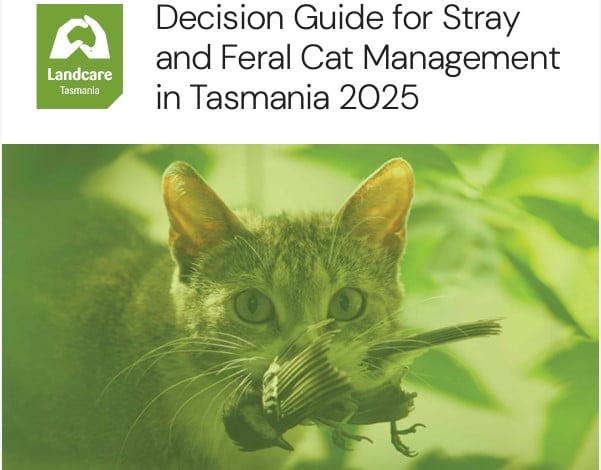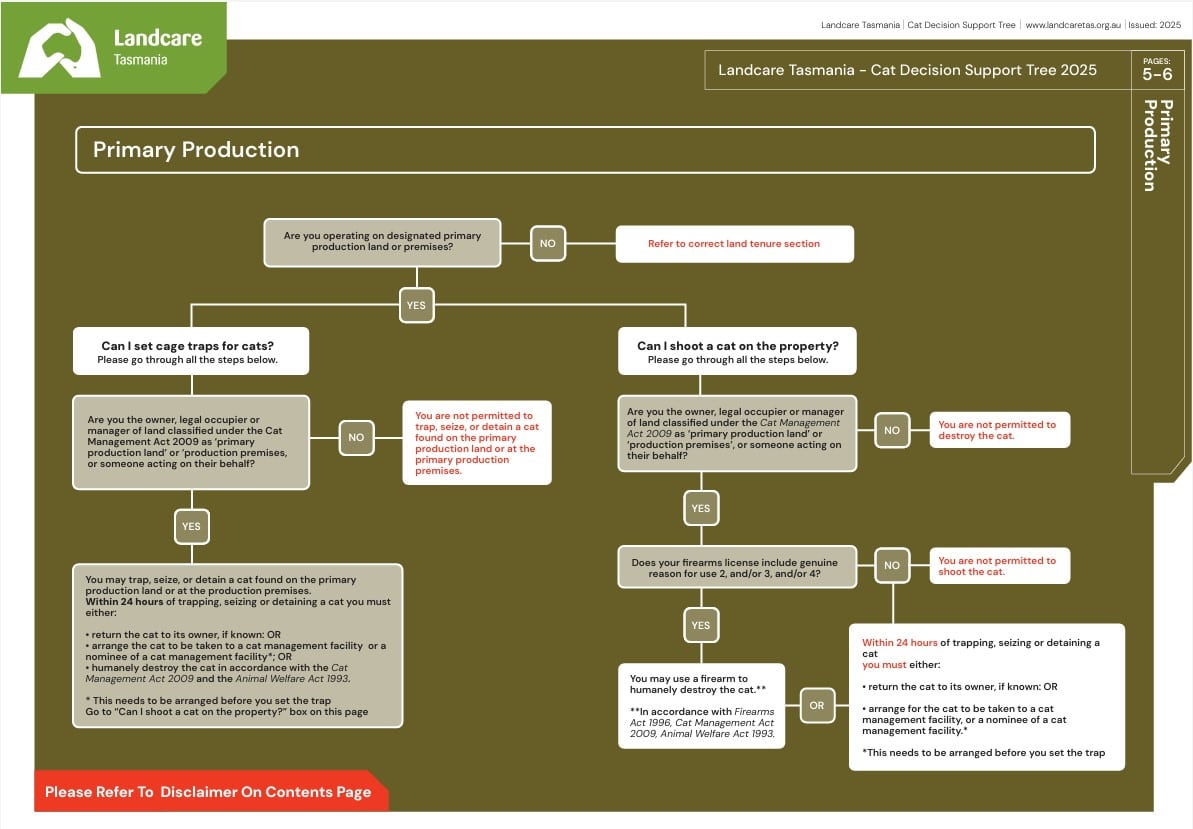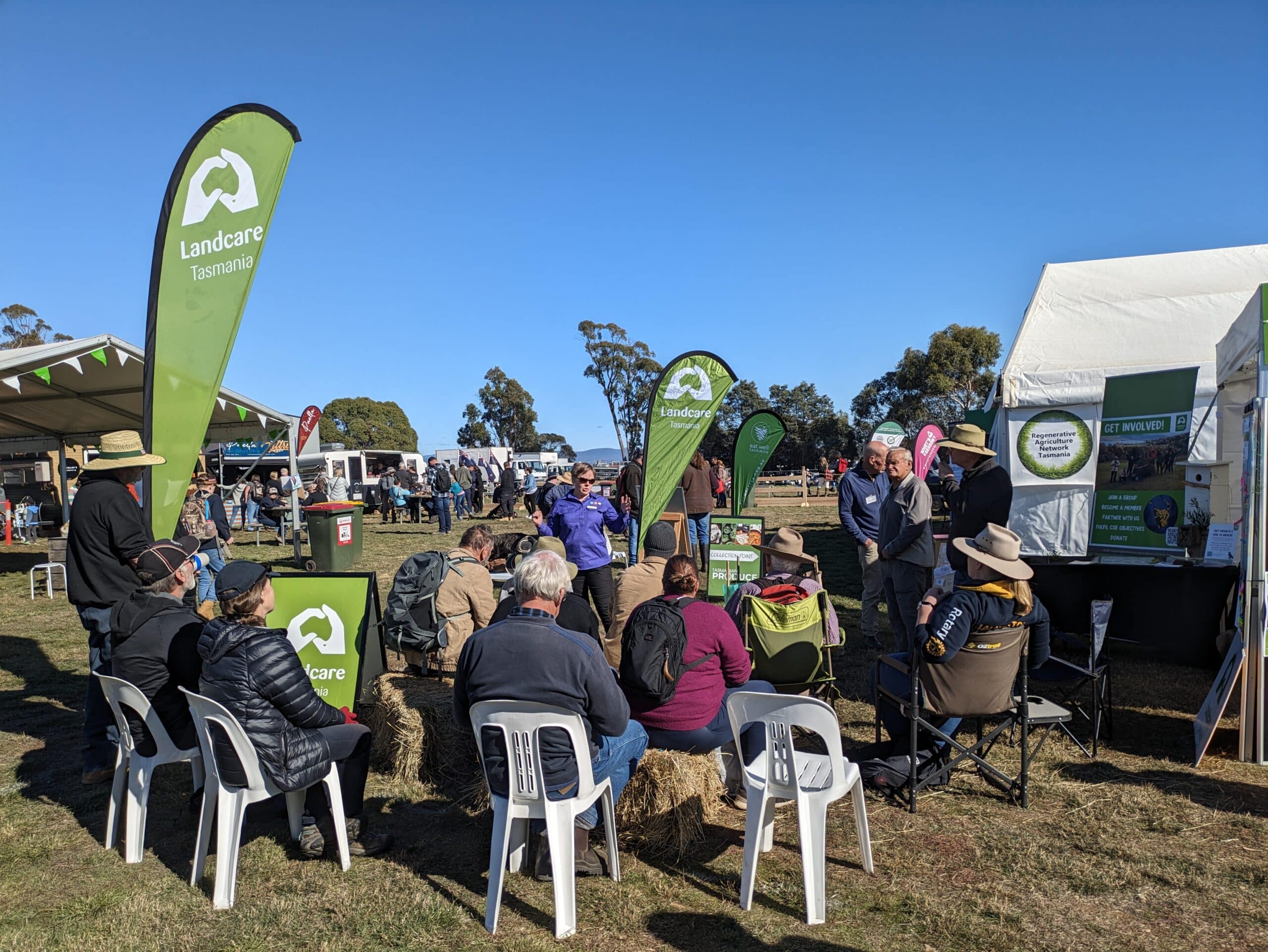Project snapshot:
The Decision Guide for Stray and Feral Cat Management in Tasmania
Showcasing Landcare Tasmania and the National Feral Cat and Fox Management Coordination Program’s collaborative work on producing a decision guide for cat management in Tasmania:
We have feral cats, what can we do about it? This is a common question that our program is understandably asked time and again. We often start our answer with some questions in return: “what state/territory are you in?”, and “what land tenure(s) are you working on”? The answers to these questions are key to determining what tools and techniques are available for feral cat management to reduce their impacts. From talking to many farmers, land managers, groups and organisations from right across Australia, it’s clear that a key barrier to effective feral cat management is not knowing how to find out what they can legally do.
What can legally be done to manage feral cats to reduce their impacts is actually a very complex question to answer. Often, information on what tools and techniques can be used can be even harder to find and understand than how best to use them. Legislation relating to feral cat management is complex, the language is not clear, and finding the right legislation can be difficult. Multiple Acts, Regulations and policies interact, overlap and can even contradict each other, creating complexity for those seeking to understand or comply with the law. Some states and territories have Cat Management Acts, plans and strategies, but not all. These documents are a useful start to understanding what can be done about feral cats in an area, but they still don’t provide people with answers to all these legal questions. They often outline why we should manage feral cats, and even where they can be controlled, but not necessarily who can do it and with what techniques. Several key questions are often unanswered, even when these documents are available – for example:
- Can you humanely euthanise trapped cats, or do you need to take it somewhere?
- Is feral cat control a “genuine reason for use” to get a firearms license in your situation?
- Is the cat you are looking at considered a “feral”, “stray” or “pet” cat? How can you tell, and what does it mean for the tools and techniques that are available to you?
- What actually is a “humane euthanasia” technique under the animal welfare legislations? (To help out with that last one, check out the National Standard Operating Procedure: Methods of euthanasia on PestSmart.)

The cover of Landcare Tasmanias new Decision Guide for Stray and Feral Cat Management in Tasmania.
In Tasmania, to overcome this challenge, Landcare Tasmania partnered with the National Feral Cat and Fox Management Coordinator to work through the different pieces of legislation with relevant Tasmanian Government departments and Tasmanian feral cat management specialists. The result of this effort was the development of the Decision Guide for Stray and Feral Cat Management in Tasmania. This step-by-step guide is designed to help landowners, farmers, residents, community groups and government agencies navigate the legislation associated with cat management activities so that they can work out what they are able to do on the land tenure they are working on. The resulting 14-page booklet, released this month, is already gaining traction. Local Landcare and conservation groups along with farmers and land managers are already using it and spreading the word among their networks.

An example page from the Landcare Decision Tree 2025 on what feral cat management techniques can be used – and by whom – on primary production land in Tasmania.
Nutting out, and nailing down, the nuances of the legislation took time. Key to the process was engaging with the relevant state agencies, to ensure the information provided was accurate. It was made a little ‘easier’ by Tasmania already having a Cat Management Act 2009, which outlines where and who can trap and humanely euthanise feral cats. Importantly, the Department of Natural Resources and Environment Tasmania (NRE Tas) has taken the step to put information on feral cat management on their website under Responsible Cat Ownership and Feral Cats. Also, there are only two management techniques available to most people, cage trapping and shooting. Even then, there are eight pieces of legislation that needed to be worked through:
- Cat Management Act 2009
- Land Tax Act 2000
- Firearms Act 1996
- Animal Welfare Act 1993
- Forest Practices Act 1985
- Forest Management Act 2013
- Nature Conservation Act 2002
- State Service Act 2000

Landcare Tasmania and the National Feral Cat and Fox Management Coordination Program work together on communicating the importance of cat management in Tasmania. Here Gill Basnett, the National Coordinator, speaks to the public at Landcare Tasmania’s stall at Agfest 2024. Image: CISS, NFCFMC Program.
The National Feral Cat and Fox Management Coordination Program is very proud of the outcome of this collaborative effort, and thanks Landcare Tasmania, the Government Departments, and the feral cat management experts who were involved for their hard work in putting together this important guide.
But what about other jurisdictions we hear you ask? For other states and territories, the NFCFMC Program is working with the Threatened Species Commissioner’s team in DCCEEW and other state and territory agencies to update the list of relevant legislation by jurisdiction in the Glovebox Guide for Managing Feral Cats (2020) and the summary of legislative support for feral cat management table. This information will also be provided on the Tools pages for feral cats on the NFCFMC website by July 2025. In the meantime check with your local state and territory state agencies for more information.
If any other organisation or agency would like to take the lead on a similar Decision Guide, the NFCFMC Program would be more than happy to partner with them.
To read the decision Guide for Stray and Feral Cat Management in Tasmania, click here.
This project snapshot initially appeared in the April 2025 issue of the National Feral Cat and Fox Management Coordination Program Newsletter. To subscribe to the newsletter, click here or fill out the form at the bottom of the page.
Banner photo: Michael Robinson.
Other Resources
Click here to find out more about FeralScan a free community-designed website and smartphone app that allows you to record observations and evidence of introduced pest animals (such as foxes and feral cats), the damage they cause (including predation of native wildlife or lambs), and control actions in your local area (such as baiting, trapping and shooting).
The PestSmart Toolkits provide further information about how to plan, manage and improve your feral cat or fox management program.
The CISS Glovebox Guides, Planning Guides and Field Guides are useful pdf or printed booklets for managing pest animals like feral cats and foxes, developing a simple feral cat or fox management plan or undertaking a best practice baiting program.
